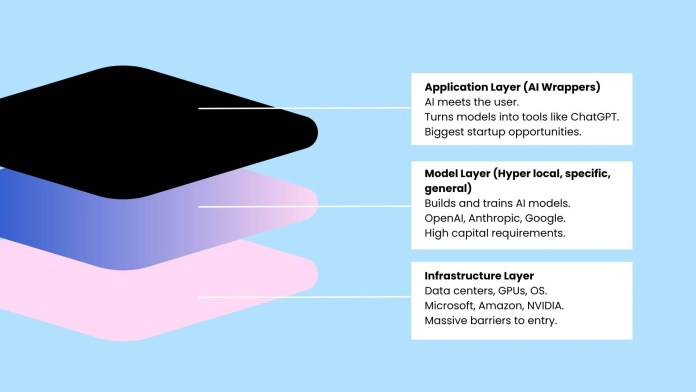Not all revolutions start with fireworks. Some slip quietly into our lives, hidden behind sleek apps and friendly interfaces. You’ve probably used one today without even knowing it, to draft an email, polish a report, or manage your finances.
These invisible helpers are called AI wrappers. While much of the spotlight shines on the large foundational models like GPT-4 or Bard, it’s the clever applications built on top of these powerful engines that are quietly democratizing AI and turning heads in investment meetings.
But what exactly are these ‘wrappers,’ and why are they becoming such hot commodities for investment? This article will peel back the layers, defining AI wrappers, exploring their appeal to investors, examining their benefits and drawbacks. Prepare to understand why these seemingly simple solutions are far more significant than they appear.
A Breakdown of the AI Technology Stack

As AI continues to evolve, it helps to picture the industry as a technology stack made up of three broad layers.
Morales notes that model and foundation layers will probably be controlled by large corporations, who will collectively pour trillions into staying ahead. But there’s fertile ground for startups operating in the application layer. They can leverage these models and APIs to provide innovative, disruptive offerings for consumer and business markets alike.
What Are AI Wrappers?
At its simplest, an AI wrapper is an application that sits on top of a powerful AI model and makes it easier to use for a specific task.
Think of it like a friendly tour guide. The AI model does all the heavy lifting behind the scenes. The wrapper just makes sure you can talk to it in plain language, gives you a nice interface, and delivers the results in a clear way.
The job of an AI wrapper isn’t to outthink the AI it’s built on. It’s to control the experience. That might mean:
- Preloading the AI with industry-specific knowledge
- Designing workflows that match how real people work
- Building dashboards, templates, and integrations that keep users coming back
- Create a consistent way to interact with various AI models. (Republic.ai is a great example of a wrapper for image generation with multiple models)
Why Investors Love AI Wrappers
Investors are always looking out for the next big thing, and AI wrappers have emerged as an attractive prospect in recent years.
Their appeal stems from several key advantages that align with investment goals:
Rapid Market Opportunity and Validation
AI wrappers are a quick route to market. Rather than investing years and millions of dollars in creating a base AI model. Startups can now rapidly create and deliver a wrapper app, proving out their concept and achieving early success. This enables rapid monetization and ROI, therefore makes them extremely attractive to venture capital investors seeking lean businesses.
Cost-Effectiveness
It is less expensive to use tested, robust AI models. Companies do not have to invest massive resources in training large models or building advanced AI infrastructure from the ground up. They can leverage the power of tested APIs, investing their resources in product building, user interface, and business growth. This efficient approach is a significant draw for investors seeking effective capital leverage.
Agility and Flexibility
Companies building AI Wrappers can readily respond to some industry requirements, shift their offerings, or incorporate new AI models as and when they are launched. This agility is extremely critical in the current rapidly changing tech landscape, keeping companies competitive and current.
Scalability
As the underlying AI models keep getting better and more robust, the wrapper apps directly benefit without much re-engineering. This quick scalability at reasonable cost is a strong indicator of future profitability and growth for investors.
Market Expansion and Accessibility
AI wrappers make higher-level AI capabilities more democratically accessible. AI wrappers open new markets by making integration simple and affordable for users who’d otherwise be left out. This expansion of the total addressable market makes AI wrapper firms attractive for their capacity to make contact with a large customer base.
Niche Solutions
AI wrappers are specialists. They can be trained to address highly specific issues in specific industries or for niche customer groups. Specialization enables them to command niche markets and establish loyal, committed customer bases, which translates to recurring revenue streams and defendable market positions.
The Flip Side of AI Wrappers: Risks and Challenges
While their value and potential for investment are undeniable, AI wrappers have their own set of challenges. Their nature, standing on the shoulders of AI, bears certain assumptions and challenges:
Perception as ‘Thin’ or ‘Copyable’
The greatest challenge may be the perception that AI wrappers are just ‘thin’ skins over existing technology with minimal defensibility and innovation. They are perceived as easily copyable, leading to a competitive market that’s overloaded and where differentiation is difficult. This is likely to cause confusion among users regarding the various value propositions of a wrapper versus use of a base model.
Third-Party Model Dependence
Third-party AI model and API dependency is perhaps the greatest vulnerability of AI wrappers. Price change, terms of service change, or even model withdrawal can impact the business structure of a wrapper significantly. Relying on another model translates to an extra risk factor.
Market Saturation
The ease of creating AI wrappers has led to rapid spread of similar products. Market saturation can hinder new entrants to differentiate themselves and acquire customers, leading to fierce competition and likely price wars
Feature Integration Risk
Larger platforms and model providers are increasingly incorporating functionalities, previously the domain of standalone AI wrappers, directly into their products. This risk is known as feature creep.
It takes strategic vision, profound understanding of what users need, and unstoppable enthusiasm to build and deliver hard value that is more than just wrapping an API. The winning companies will be those that build great brands, develop strong user communities, and innovate relentlessly on the user experience and problem-solving capability.
Examples of AI Wrappers
AI wrappers are already everywhere, oftentimes without us even realizing it. They are the unobtrusive enablers that make AI power accessible to our fingertips. Here are some tangible examples illustrating their diverse applications:
1. Document Interaction Tools
Perhaps the most well-known AI wrappers are applications that allow an individual to “speak” to PDFs or other documents. They allow users to input a document and then ask questions of its contents, summarize subsections, or pull out highlights. The wrapper communicates with a back-end Large Language Model (LLM) to perform the questions and produce answers based on the document’s text, basically converting static documents into interactive knowledge bases. Eg: ChatPDF
2. Specialized Content Generation Platforms:
Kernel LLMs are capable of generating text, but AI wrappers make this function specialized in some applications. They employ an LLM but with industry-specific fine-tuning, ease of use, and integration into marketing processes. This allows companies to quickly generate content that is personalized without requiring in-depth AI knowledge. Eg: Jasper AI
For those looking to optimize their AI interactions, exploring a prompt marketplace can provide valuable pre-designed prompts and strategies, further enhancing the efficiency of AI wrappers.
3. Enhanced Customer Service Bots:
AI-powered customer service chatbots are now common in most companies. An AI wrapper can take a general-purpose conversational AI model and add company-specific functionality on top. This could include connecting to CRM systems, querying product databases, or guiding users through diagnostic troubleshooting flows. These additions make the bot more streamlined and targeted than a plain LLM.

So, what is the verdict on AI wrappers? If you are an investor searching for the next unicorn, a consumer looking for smarter tools, or a developer building the future, one thing is clear: AI wrappers are not merely a clever trick. They are the necessary bridges in the AI ecosystem, bridging raw potential to real-world realities.
For investors, they are a practical path to benefiting from the AI boom. For consumers, they are the friendly face of an intricate technology. And for coders, they are a canvas for imagination.
If done right!



